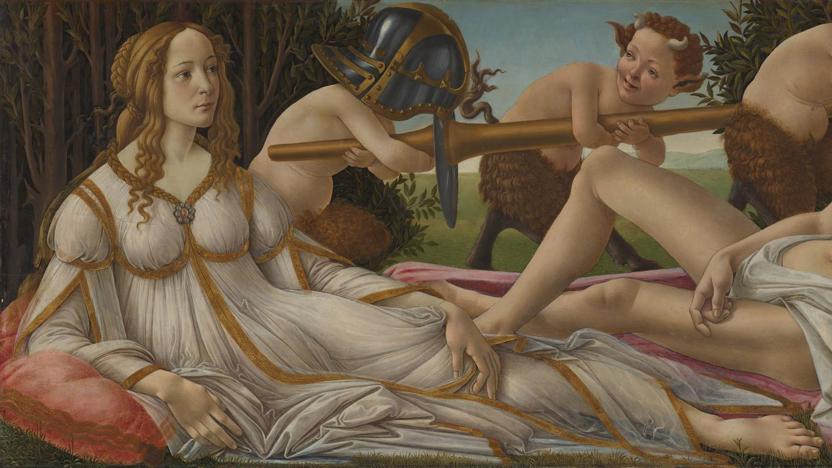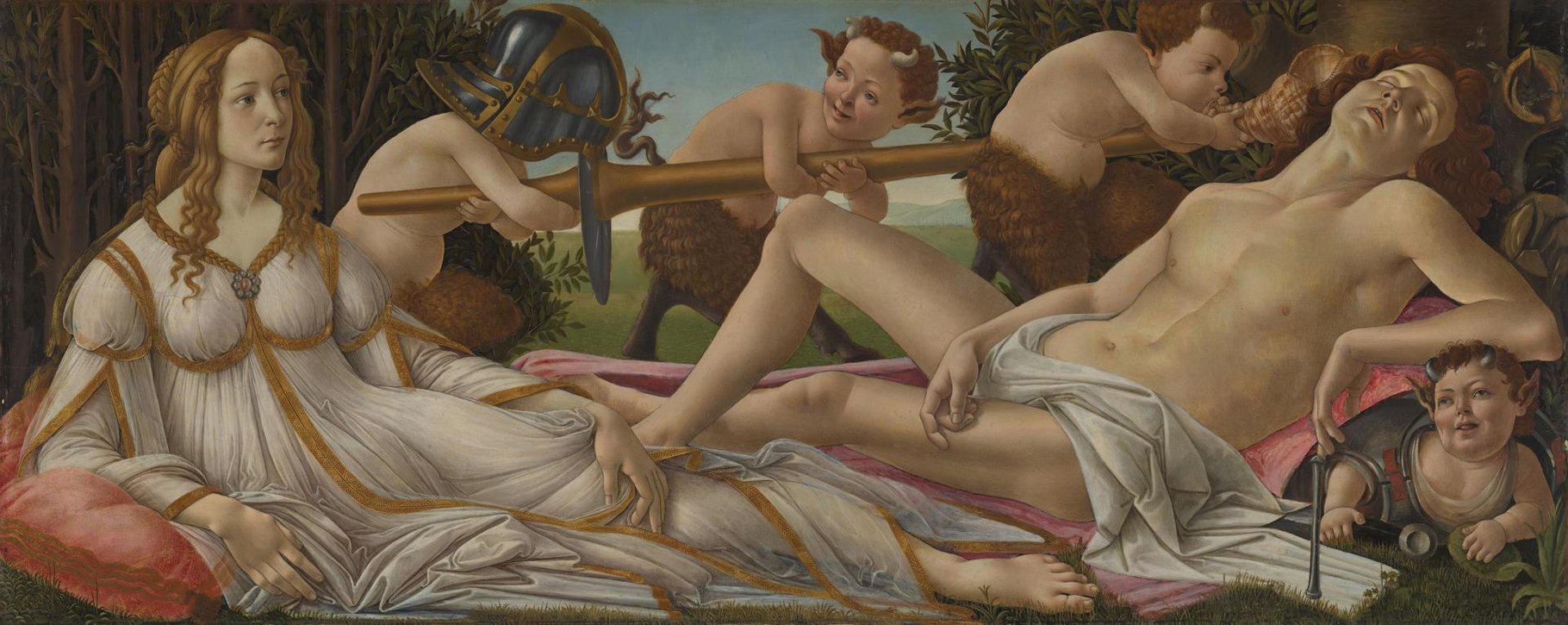Botticelli’s 'Venus and Mars'
Audio description
This is a description of Venus and Mars, a painting by the Renaissance artist Sandro Botticelli dating to about 1485. It is a long, rectangular picture: painted with bright tempera and oil paints on a poplar wood panel. It is landscape orientated, about 70 centimetres tall and over 1 meter and 80 centimetres. The painting shows a young couple — both around 20 years old — lounging leisurely outdoors in a grassy clearing flanked by dense woodland and shrubbery. They face one another, their legs stretched out in front of them and very close. Although their reclining bodies fill the length of the canvas, there is enough space for four satyrs to crowd in, and tiptoe around them. These creatures belong to Greek mythology and resemble seven-year-old boys with cute potbellies. But also have furry legs, pointy ears and little, curved horns of goats. The young couple isn’t human either: on the left, Botticelli represented Venus, Goddess of Love, and on the right Mars, God of War. In the background, dark and light, brown and green brushstrokes, form trees and leaves on either side of the young couple. In the centre of the panel, the grassy landscape recedes further into the distance to soft green hills under a pale blue sky. On the right, faint shapes indicate a walled city beside a body of water. Venus and Mars command the space in the foreground. Venus lies on her side, her upper torso propped up on a pink cushion. It is a sunny,
summery day and she wears light clothing: a white pleated robe with slashed sleeves and a semi-transparent veil covering her body down to the ankle. Gold embroidered trim hems her garments outline her v-shaped neckline, round shoulders and breasts. Venus has long golden hair, swept back in a bun with elaborate plaits and loose ringlets framing her face. Her divine, pale, oval-shaped face and sharp chin. There is a gentle smile on her pale, rosy lips. Her brown eyes are alert, and her gaze is directed across at her companion. Opposite her, Mars is deep in slumber. His strong and fit body is sprawled out on a pink cloak, with one leg bent at the knee and the other stretched out behind the legs of Venus. The cloak is pulled taut as the toes of his outstretched foot get caught in its folds. His upper body is propped up on his empty grey metal breastplate which he is using as a pillow. His right arm lies in his lap and his left is bent, the fingers of this hand hanging above the hilt of his sword which is thrown on the grass, the blade hidden beneath the mantle. Crowned with a large mass of ginger-brown, curly hair, his head is thrown backwards with his thick neck fully extended. A satisfied expression on his face, his lips softly parted. He seems happily asleep and lost in his dreams. Mars is fully naked apart from a loose piece of white drapery that makes a small loincloth around his waist. His entire figure speaks of hulking strength. He might be a mighty warrior but he’s depicted as careless here: he
hasn’t been woken up by the satyr who has sneaked into his breastplate, leering cheekily with a hand on the sword’s hilt. Nor has Mars heeded the three satyrs, who tiptoe behind the young couple, moving from left to right, brandishing Mars’ lance. One cheeky satyr has also put on Mars grey metal helmet, while another, with puffed-out cheeks, blows into a large conch shell close to the Mars’ right ear. Next to his other ear, a swarm of wasps buzzes in and out of a hole in the tree behind him. We are held in suspense, moments before a cacophony of sound and action erupts: Mars could start at the loud honk, get stung by angry wasps and unleash his anger and fury.
You might think satyrs should have known better than to mess with Mars. But here, Botticelli presents a satire in painting, to make us laugh and ponder. We would miss two crucial details in fact if it weren’t for satyrs’ presence. First, the satyrs have sly, pernicious expressions on their round faces and rolled tongues in their open tiny mouths. They make fun of Mars’ lethargy, a reference to his exhaustion after physical intimacy. Some of the visual clues in the painting can also be interpreted as sexual innuendos: the long, erected lance; the sword's stiff blade; the deep opening in the conch shell; the large hole in the tree. The second detail is even more critical. The satyrs’ mythological nature is after all, the only visual signal that this well-off, ordinary couple of extraordinary beauty is actually divine and supernatural, revealing that they are indeed Mars and Venus.


